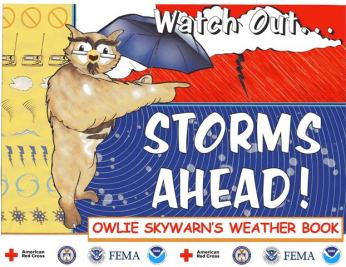With the threat of an unusual “Frankenstorm” pre-Halloween hurricane possibly combined with a blizzard about to hit the East Coast in the next few days, I found myself with a dozen others at the store last night buying batteries, flashlights and bottled water. Next to me was a mother with two small children, one of whom asked loudly, “Mommy, why is everybody buying batteries and water?” I chuckled to myself as I looked at the frazzled adults and wondered how she’d explain what the fuss was about. With the rise in severe weather events in the United States and the related rise in media coverage about these creating anxiety in both young and old, parents and teachers have a lot of “‘splaining” to do to children.
 Fortunately, NOAA, the National Oceanic and Atmospheric Administration, in conjunction with FEMA (the Federal Emergency Management Association) and the American Red Cross, have prepared a terrific new booklet, Owlie Skywarn’s Weather Book, to explain different types of severe weather and how to prepare for each.
Fortunately, NOAA, the National Oceanic and Atmospheric Administration, in conjunction with FEMA (the Federal Emergency Management Association) and the American Red Cross, have prepared a terrific new booklet, Owlie Skywarn’s Weather Book, to explain different types of severe weather and how to prepare for each.
Although formatted to appeal to children, with “Owlie Skywarn” the cartoon weather owl introducing topics on most pages, this booklet is valuable for all ages.
The book covers the gamut of severe weather, from hurricanes and tornadoes to lightning, floods and winter storms.
For each type of weather, Owlie explains what it is, what kind of alerts or warnings may be issued and by whom, how to prepare in advance (if possible), and how to react while it is happening. For example, a great page illustrates a car safety kit every driver should have if he or she lives in places that get deep snow. Still other pages tell you where to go and how to protect yourself when a tornado warning is issued by NOAA’s National Weather Service, or over the Emergency Alert System, whether at home, school, office, store, outdoors or in a car.
Sprinkled throughout are anecdotes from real people and towns that make the advice come alive. One is the story of a retired National Park Ranger who has been struck by lightning seven times and lived to tell the tale (albeit now with lightning rods all over his home). Yikes! Fascinating (and intimidating) weather facts are included like the fact that the most snow in one month in the United States actually fell in Tamarack, California, in 1911: a whopping 32.5 feet or 390 inches (or 10 meters for our non-US readers)!
At the end of the book are quizzes and activities that can be used by a family at home or teachers in school with children to help ensure the lessons get through that severe weather is not to be played with.
My recommendation to parents, teachers, well, really everyone is get a copy of Owlie Skywarn’s Weather Book, read it, prepare, and keep it with your other extreme weather supplies. These are lessons worth repeating often. I’ve got my copy with my spare batteries and my NOAA weather emergency radio.
P.S. And to that mother in the flashlight and batteries aisle preparing for Hurricane Sandy: You will be happy to know that the answer to your daughter’s question about why everyone is buying batteries and water can be found on page 6.
HOW DO I OBTAIN “Owlie Skywarn’s Weather Book”?
- Buy it online 24/7 at GPO’s Online Bookstore.
- Buy it at GPO’s retail bookstore at 710 North Capitol Street NW, Washington, DC 20401, open Monday-Friday, 9am to 4pm, except Federal holidays, (202) 512-0132.
- Find it in a library.
Find this and other books about Weather and Climate on our new online bookstore.
About the Author: Michele Bartram is Promotions Manager for GPO’s Publication and Information Sales Division in Washington, DC, and is responsible for online and offline marketing of the US Government Online Bookstore (http://bookstore.gpo.gov) and promoting Federal government content to the public.




 Posted by GPOBookstore
Posted by GPOBookstore 












